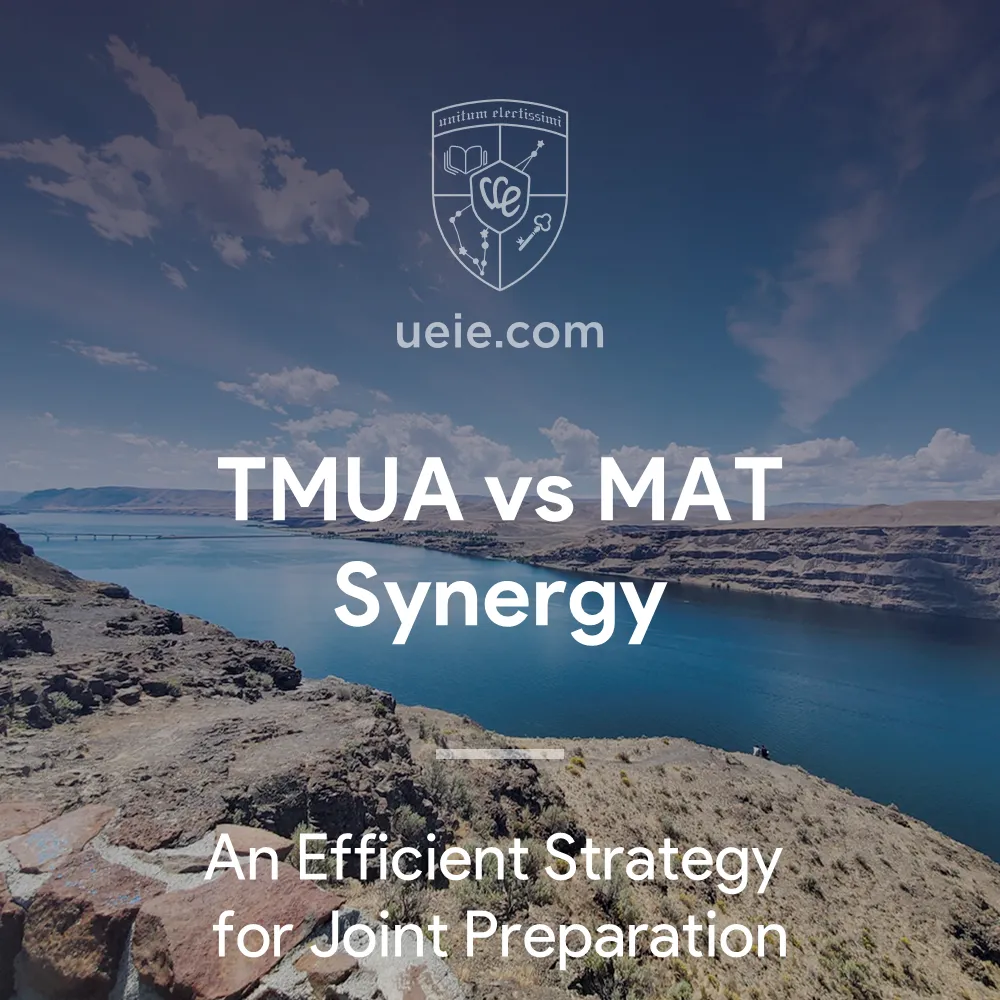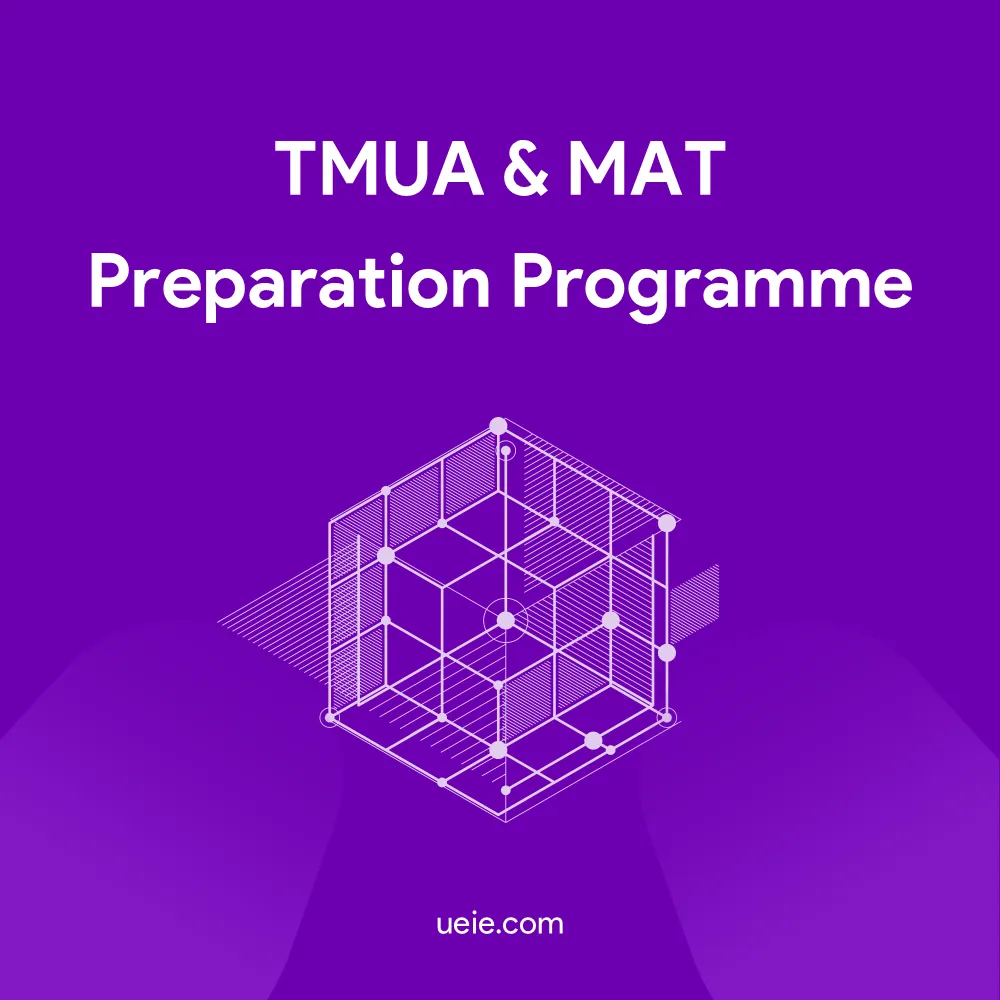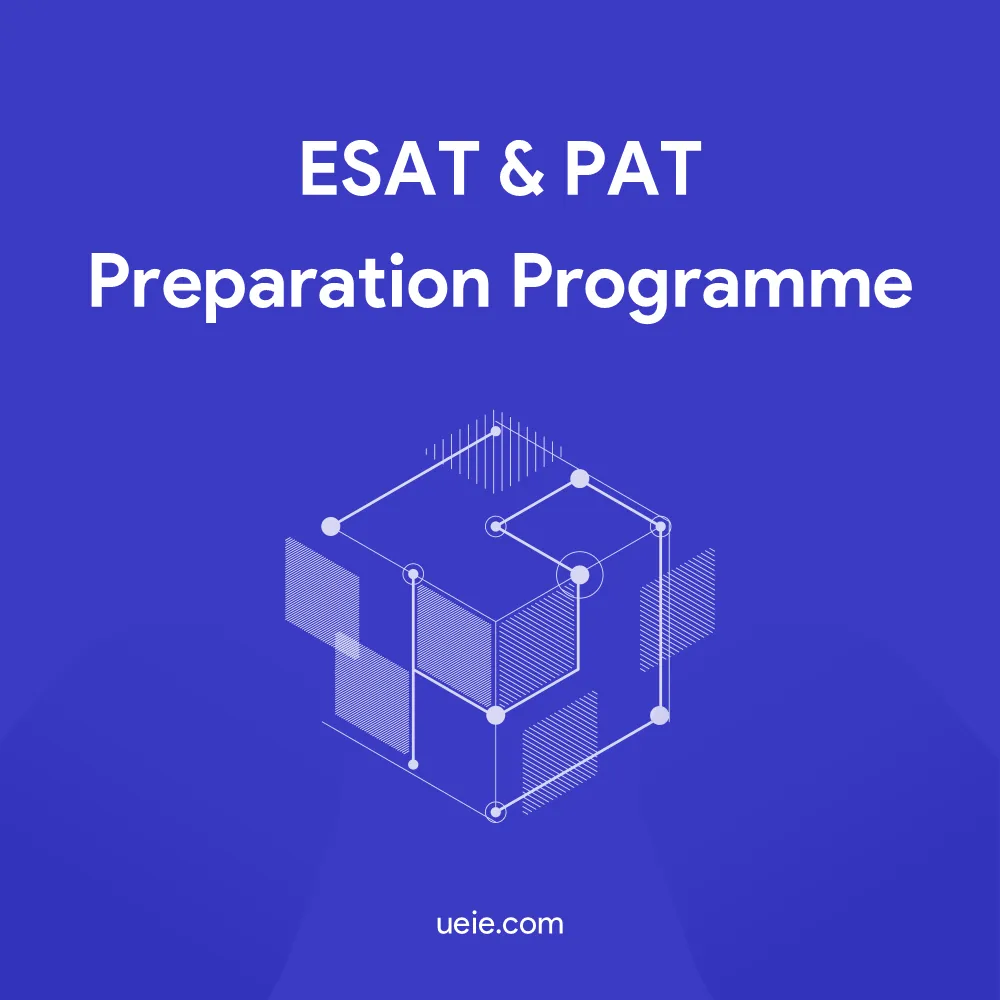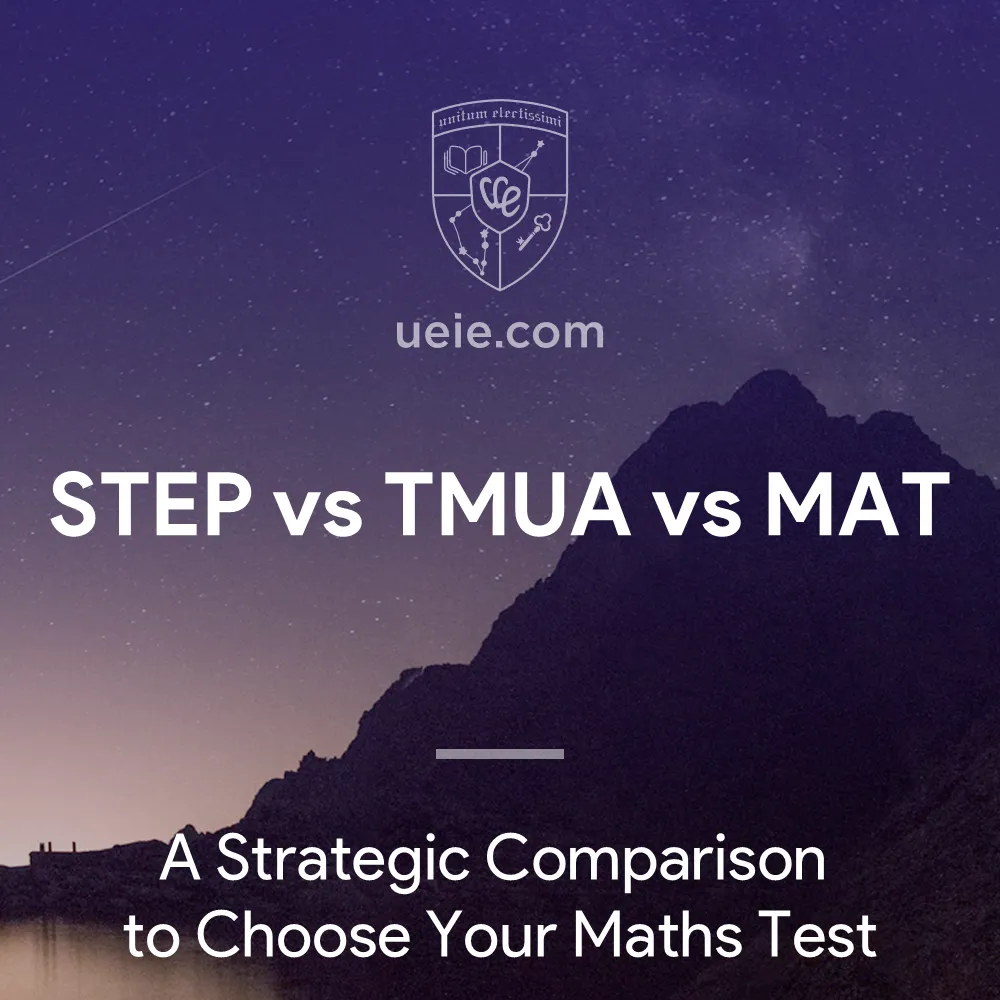Your cart is currently empty!
Tag: Comprehensive Comparison
-

TMUA vs MAT Synergy: An Efficient Strategy for Joint Preparation
I. TMUA vs Oxford MAT: Why Are They So Often Mentioned Together?
Prospective students and parents targeting mathematics, computer science, economics, or other sought-after degree programmes at Oxbridge or other G5 universities will likely be familiar with the TMUA and the Oxford MAT (hereafter MAT) – two key mathematics admissions tests. Astute parents and students may have already spotted a crucial distinction: TMUA vs MAT — one examination (TMUA) is composed entirely of multiple-choice questions, while the other (MAT) features both multiple-choice and extended-response questions. These are fundamentally different examinations, so why are they often mentioned in the same breath, or even recommended for concurrent preparation? Could this approach dilute one’s focus?
This is an exceedingly common and pertinent query. This article aims to demystify the situation by directly comparing the TMUA and MAT, thereby revealing their ‘intrinsic connection’. I will explain why, for many students, preparing for these two examinations in tandem is, in fact, a more astute and efficient strategy – one capable of producing a synergistic effect greater than the sum of its parts (a ‘1+1>2’ outcome) – and will outline a clear and practical path to achieve this.
II. TMUA vs MAT: A Table for Understanding Core Similarities and Differences
First, let us consolidate the key information for the TMUA and MAT into a table, enabling you to discern their most crucial similarities and differences at a glance:
Dimension TMUA Oxford MAT Managing Body UAT-UK University of Oxford Exam Delivery Partner Pearson VUE Pearson VUE Response Format Online, computer-based Online, computer-based Question Types & Quantity 40 multiple-choice questions 25 multiple-choice questions + 2 extended-response questions Examination Duration 2.5 hours 2.5 hours Knowledge Base Primarily based on A Level Mathematics + some GCSE Mathematics Primarily based on A Level Mathematics Further Mathematics Not required Not required Examination Style Emphasis on speed and precision Emphasis on thinking and logic Assessed Abilities Rapid and accurate application of knowledge; logical reasoning agility. Rigorous logical thinking; creative problem-solving. Permitted Aids Calculators, formula sheets, and dictionaries are all prohibited. Calculators, formula sheets, and dictionaries are all prohibited. Scoring Method Standardised score: 1.0-9.0 (converted from raw score) Raw score: 0-100 Typical Universities / Majors - Cambridge (Computer Science, Economics) and compulsory for some Imperial/LSE/UCL programmes.
- Accepted or alternative for some Warwick/Durham programmes.
- Compulsory for Oxford Mathematics/Computer Science related programmes.
Keywords Speed, accuracy, logical reasoning, broad application Logic, problem-solving, mental flexibility, Oxford Brief Summary
Upon reviewing the table, you will observe that the TMUA and MAT do indeed exhibit distinct differences in question format (one being purely multiple-choice, the other a hybrid) and style (one prioritising speed, the other depth). However, their commonalities are also remarkably prominent: both are computer-based examinations, neither necessitates Further Mathematics, both are founded upon A Level core mathematics knowledge, and both place considerable emphasis on logical aptitude. These shared characteristics precisely form the basis upon which we can implement an effective joint preparation strategy.
III. ‘Combination’ and ‘Separation’: The Rationale and Key Aspects of TMUA MAT Joint Preparation
Having understood the core similarities and differences, you can now appreciate why the TMUA and MAT are suitable for ‘combined’ preparation, and yet necessitate ‘separate’ training in certain aspects.
1. Why ‘Combine’? – Unveiling the Intrinsic Connection
The feasibility and efficacy of joint preparation primarily stem from their close ‘intrinsic connection’.
A Highly Overlapping Knowledge System is Core
This is the most crucial point! Both the TMUA and MAT predominantly assess A Level Mathematics knowledge (mainly Pure Mathematics with a small amount of Statistics). Both are built upon core secondary school mathematics knowledge and neither requires the additional burden of studying Further Mathematics. This implies that when revising fundamental modules such as functions, algebra, calculus, and coordinate geometry, a single study pass can satisfy the majority of the knowledge requirements for both examinations, thereby avoiding substantial duplication of effort. This is the most significant efficiency gain!
Underlying Skills are Transferable
Whether it is the TMUA’s demand for rapid and accurate logical judgement or the MAT’s requirement for rigorous and in-depth logical analysis, a sound foundation in logical thinking is essential. Similarly, solid fundamental calculation skills, the ability to accurately express oneself using mathematical language, and basic problem deconstruction capabilities are vital for both examinations. Training these underlying skills can yield a ‘dual benefit from a single effort’.
Consistent Examination Environment
Both are computer-based examinations conducted at Pearson VUE test centres. Familiarity with the computer-based testing environment, on-screen reading, and online answering procedures is entirely transferable, reducing adaptation costs.
In simple terms, if we liken examination preparation to constructing a house, the foundational materials and load-bearing columns (core knowledge, underlying skills, examination environment) for the TMUA and Oxford MAT are largely identical. Tutors can construct them simultaneously, saving both time and effort.
2. Why ‘Separate’? – Unique Skills Require Dedicated Practice
Naturally, identical foundations do not equate to identical houses. The TMUA and MAT have different emphases regarding skill requirements; therefore, students must undertake specialised training separately.
TMUA is like a ‘Sprint’
It demands that students unleash their maximum problem-solving speed and accuracy within an extremely limited timeframe. Consequently, extensive timed multiple-choice question practice is imperative. Students must become proficient in various multiple-choice techniques (such as rapid elimination, substitution of special values, etc.) and develop time management into an ingrained habit. Merely possessing knowledge without the requisite techniques and speed will not suffice to achieve a high score in the TMUA.
MAT is like ‘Puzzle Solving and Questing’
It places greater emphasis on a student’s depth of thought and creativity when confronted with unfamiliar problems. Therefore, dedicated practice is needed in deconstructing novel problems, conducting in-depth logical analysis, and learning how to articulate problem-solving processes clearly via the keyboard (to address the extended-response questions). Practising only multiple-choice techniques will not adequately prepare one for the unique intellectual challenges posed by the MAT.
3. TMUA vs MAT: Brief Summary
The foundational elements of TMUA and MAT preparation can be tackled together, akin to building overall physical fitness; however, specific skills must be honed separately – a sprinter and a puzzle master will undoubtedly have different specialised training regimens.
IV. The Efficient Path: The ‘1+1>2’ Approach to Joint Preparation
Understanding the rationale behind ‘combination’ and ‘separation’ allows us to devise an efficient joint preparation path that truly achieves a ‘1+1>2’ effect.
1. Wherein Lie the Advantages of ‘1+1>2’?
The benefits of jointly preparing for the TMUA and MAT are tangible:
- Time-saving: This is the paramount advantage. Foundational knowledge need only be revised once, averting the repetitive investment of substantial time.
- Efficient: The enhancement of core abilities (such as logic and calculation) simultaneously benefits both examinations, creating a synergistic learning effect.
- Effort-saving: Familiarisation with the computer-based testing platform and procedures is only required once.
- Pragmatic: For students planning to apply simultaneously to Oxford and other top universities requiring the TMUA, this is the most natural and highly efficient strategy.
2. How to Achieve Efficient TMUA MAT Joint Preparation?
The key to efficient joint preparation lies in ‘strategy’:
Fundamental Path: Communalities First, Differences Later
- Step One (Laying the Foundation): Concentrate efforts on revising and consolidating the common A Level/AS core mathematics knowledge, ensuring conceptual clarity, formulaic proficiency, and computational accuracy. Concurrently, cultivate fundamental logical thinking skills.
- Step Two (Building the Framework, Dividing the Rooms): Once the foundation is solid, begin introducing targeted practice. On one hand, commence MAT-style in-depth thinking and problem-solving training; on the other, start TMUA-style timed practice to cultivate an initial sense of speed and multiple-choice question response capability.
- Step Three (Fine-Tuning): Enter the intensive phase, increasing the intensity of specialised training. Engage in extensive timed TMUA multiple-choice question practice, rigorously focusing on speed and accuracy. Simultaneously, concentrate on tackling past MAT papers and challenging problems to refine depth of thought and skills for answering short-answer questions.
Recommended Preparation Time
Generally, a systematic preparation period of 5-10 months is considered reasonable (the specific duration will vary depending on the student’s foundational knowledge). The crucial aspect is to commence early and ensure consistent, sustained effort.
Official Resources are Fundamental
Official materials (such as sample questions from the TMUA and MAT official websites, syllabuses, past papers, etc.) are fundamental and must be utilised effectively.
Considering the unique aspects of joint preparation, opting for specially designed joint preparation courses and materials tailored to the characteristics of both the TMUA and MAT will prove to be significantly more effective. For example, the TMUA+MAT On-Demand Prep Suite and the TMUA+MAT Live Classes offered by UEIE.
Key Recommended Resources

TMUA & MAT On-Demand Prep Suite
The TMUA & MAT On-Demand Prep Suite is your all-in-one solution for exam success. This comprehensive package combines Xie Tao’s expert video lectures, a massive bank of 1360 practice questions with detailed solutions, and 12 full-length mock exams that mirror the real test. Prepare thoroughly, build confidence, and achieve your target score.¥8,980 – ¥12,980Price range: ¥8,980 through ¥12,980

TMUA & MAT Preparation Programme
Prep for both and save time. This all-in-one programme provides 130 periods, 9 unseen TMUA mocks, 3 predictive papers, and 6 MAT mocks, helping you systematically master both exams. Click to view the bundle.¥21,800 – ¥89,800Price range: ¥21,800 through ¥89,800
The greatest value of such resources lies in their optimised design, which already incorporates the ‘combination’ and ‘separation’ learning paths and training content based on the similarities and differences between the two examinations. They can clearly guide students on what to learn first, what to practise subsequently, and how to practise most efficiently, thereby averting the potential waste of time and energy that might arise from students’ own trial-and-error efforts. For those pursuing highly efficient preparation, this is an exceedingly judicious choice.
3. Reassurance for Parents
Some parents may harbour concerns: Will preparing for both simultaneously result in neither being mastered thoroughly? On the contrary, a scientific approach to joint preparation is a more intelligent learning strategy. It does not merely amalgamate the content of the two examinations; rather, by integrating the common foundational components, it conserves precious time and energy, enabling the child to address the unique difficulties and skill requirements of each examination with greater composure and focus. This is a structured, efficiency-oriented method, the objective of which is to maximise the outcome of the preparation.
V. Conclusion: Bid Farewell to Indecision, Progress Efficiently
In summary, whilst the TMUA and MAT differ in their assessment styles and specific question types, their close ‘intrinsic connection’ in terms of knowledge base and core competency requirements makes joint preparation not only entirely feasible but, for many ambitious students, an intelligent path capable of genuinely enhancing efficiency and achieving a ‘1+1>2’ effect.
The key to success lies in employing appropriate methodology: fully leveraging their commonalities to efficiently establish a solid foundation, whilst also clearly recognising their differences and undertaking precise, specialised skills training.
It is hoped that the analysis herein will help to dispel any doubts and instil confidence in your forthcoming preparation planning. It is advisable to consider adopting structured, systematic joint preparation schemes and high-quality resources to ensure a smoother and more efficient preparation journey.
Want to learn more? Please see:

TMUA Prep Hub
Master the TMUA with UEIE’s Prep Hub! We offer everything you need to succeed: in-depth video lecture series, extensive practice question bank, realistic full-length mock exams, expert guides, and insightful data analysis.
Oxford MAT Prep Hub
Master the Oxford MAT with UEIE’s Prep Hub! We offer everything you need to succeed: in-depth video lecture series, extensive practice question bank, realistic full-length mock exams, expert guides, and insightful data analysis. -

ESAT vs PAT Comparison: Strategies for Engineering & Science Test Prep
I. ESAT vs PAT: How to Choose Your Key to Top Science and Engineering Universities?
For students and parents preparing applications for engineering or science courses at Oxford, Cambridge, and Imperial College London, the names PAT (Oxford Physics Aptitude Test) and ESAT (Engineering and Science Admissions Test) will likely ring a bell. These are crucial ‘acid tests’ used by these top-tier institutions to select applicants for their science and engineering disciplines.
A common question naturally arises, particularly for those students and parents aiming for engineering or physics programmes at both Oxford and Cambridge/Imperial College: Given that both are science and engineering-related examinations, how significant are the differences between ESAT and PAT? If my child needs to prepare for both, is there an efficient way to combine their preparation? Or are they entirely distinct, requiring separate and independent study?
Admittedly, not all science applicants will need to tackle both examinations. For instance, those applying for courses in chemistry or biology-related fields (ESAT is required for Chemical Engineering and Biotechnology, biological streams of Natural Sciences, and Veterinary Medicine at Cambridge) or materials science (PAT is required for Oxford) typically only need to prepare for one.
This article will delve into the core similarities and differences between the ESAT and PAT examinations. Our aim is to clarify the landscape for all students and parents interested in ESAT and PAT. Specifically for those needing to prepare for both – students applying for engineering or physics – we will focus on analysing the ‘correlation’ and ‘differences’ in their preparation, offering an effective combined strategy. For students who only need to take one examination, this comparison will also provide a deeper understanding of the unique aspects of the exam they face, thereby enabling more targeted preparation.
II. ESAT vs PAT: A Table for Understanding Core Information
First, let’s condense the key information about ESAT and PAT into a table. This will allow you to quickly grasp their overall structure and core differences.
Dimension ESAT Oxford PAT Managing Body UAT-UK University of Oxford Exam Administrator Pearson VUE Pearson VUE Answering Format Online computer-based Online computer-based Paper Structure Total of 5 modules, typically choose 3:
-
- Mathematics 1
- Mathematics 2
- Physics
- Chemistry
- Biology
Unified paper: Mathematics + Physics Question Types and Volume 81 multiple-choice questions (3 modules, 27 questions/module) 40 multiple-choice questions Examination Duration 2 hours in total (3 modules, 40 minutes/module) 2 hours Knowledge Base A Level + GCSE Mathematics / Physics / Chemistry / Biology (depending on selected modules) A Level + GCSE Mathematics + Physics Further Mathematics Not required Not required Scoring Method Standardised score: 1.0-9.0 (after raw score conversion) Raw score: 0-100 Calculator Not permitted Online calculator provided (personal calculators forbidden) Dictionary and Formula Sheet Not permitted Not permitted Required by University/Department - Cambridge: Engineering, Natural Sciences, Chemical Engineering and Biotechnology, Veterinary Medicine
- Imperial College London: Department of Aeronautics, Department of Chemical Engineering, Department of Civil and Environmental Engineering, Dyson School of Design Engineering, Department of Electrical and Electronic Engineering, Department of Mechanical1 Engineering, Department of Physics
- UCL: Electronic and Electrical Engineering
- Oxford: Physics, Physics and Philosophy, Engineering, Materials Science
Summary
As the table above illustrates, both ESAT and PAT are online, multiple-choice examinations administered by Pearson VUE, aimed at applicants for top university science and engineering courses, and neither requires knowledge of Further Mathematics. However, they differ in the breadth of subjects covered (ESAT is broader), whether they are modular (ESAT is), calculator policies, and the final presentation of scores (standardised score vs. raw score).
III. Analysis of Similarities and Differences: Feasibility and Key Points for Combined Preparation
Having grasped the core information, let’s now delve into the feasibility of preparing for ESAT and PAT concurrently, highlighting key areas that demand particular attention.
1. Where does the ‘Feasibility’ of Combined Preparation Lie?
For students aiming to tackle both examinations (specifically those selecting the Mathematics 2 + Physics modules for ESAT), a combined preparation strategy is indeed feasible. This is primarily due to the following commonalities:
Overlapping Mathematical and Physics Knowledge
The content required for ESAT’s Mathematics 1, Mathematics 2, and Physics modules significantly overlaps with the A-Level/GCSE Mathematics and Physics knowledge needed for PAT. This means that when revising core topics such as functions, mechanics, electricity, and basic calculus, you can effectively ‘kill two birds with one stone.’
Shared Skillset
Both examinations place considerable emphasis on a student’s logical-mathematical reasoning, their ability to apply scientific principles to solve practical problems, and their capacity to maintain clear thinking and accuracy under pressure. Honing these core scientific literacies will benefit performance in both tests.
Similar Format
Both are online multiple-choice examinations administered via the Pearson VUE platform. Familiarity with the computer-based testing environment, on-screen reading, and multiple-choice answering techniques is transferable between the two.
2. What are the ‘Points to Note’ for Combined Preparation?
Despite these commonalities, it’s crucial not to treat ESAT and PAT as interchangeable. You must clearly recognise and specifically address the following key distinctions:
ESAT’s Modularity and Breadth
ESAT is structured into five modules: Mathematics, Physics, Chemistry, and Biology. Students must select and prepare for three of these, guided by their university application requirements. This implies a potentially broader knowledge base (particularly if Chemistry or Biology is chosen). Furthermore, during the exam, students will need to swiftly switch between different subject mindsets and manage their time effectively within the independent 40-minute slots allocated to each module.
PAT’s Integration of Physics and Mathematics, and Depth
While PAT only tests Physics and Mathematics, it strongly emphasises their deep integration in problem-solving. Questions may be more comprehensively and ingeniously designed, potentially demanding a more profound understanding of physical concepts and a more versatile application of mathematical tools.
Fundamental Difference in Calculator Policy
This is a critical distinction requiring careful attention:
- ESAT does not permit calculator use. Preparation must therefore involve significant effort in training mental arithmetic, manual calculation, estimation, unit conversion, and the fluent recall of formulae and constants.
- PAT, conversely, provides an online calculator. During preparation, students cannot rely on their familiar personal calculators. Instead, they must invest time in becoming proficient with the specific online tool provided. This includes learning to judge when to use it for complex calculations and when manual calculation or estimation might be more efficient. The training for these two distinct calculation approaches and skillsets is fundamentally different.
Differing Emphasis on Speed
ESAT allocates 40 minutes for 27 questions per module, averaging roughly 1.5 minutes per question. This demands exceptionally rapid knowledge retrieval and reaction speed. PAT, while also multiple-choice and with a total duration of 2 hours for 40 questions (averaging about 3 minutes per question), might appear slightly more relaxed. However, its questions may require more time for thorough reading, comprehension, modelling, and calculation (especially when using the online calculator). Consequently, it places equally high demands on depth of thought and problem-solving efficiency.
IV. Effective Strategy: Devising Your ESAT and PAT Preparation Plan
Having clarified the similarities and differences, we can now formulate an effective preparation strategy, particularly for students requiring combined preparation.
1. From Where Does ‘Effectiveness’ Originate? When is it Applicable?
The ‘effectiveness’ of combined preparation primarily stems from integrating common foundations. It is especially applicable to students whose application pathways cover related courses at Oxford and Cambridge/Imperial College, and who select the Mathematics and Physics modules for ESAT. Consolidating the revision of core mathematical and physical knowledge can effectively save time. However, please remember that the realisation of this efficiency must be predicated on precise, differentiated training.
2. Practical Advice: How to Approach Combined Preparation?
Step One: Confirm Modules and Self-Assess
Firstly, confirm that your chosen course requires or allows the selection of ESAT’s Mathematics 2 and Physics modules! This is the prerequisite for combined preparation. Secondly, objectively assess your proficiency in Mathematics, Physics (and other ESAT elective subjects), and your abilities both with and without calculator assistance.
Step Two: Consolidate Common Foundations
Systematically revise and consolidate the overlapping A Level Mathematics and Physics core knowledge points. Focus on conceptual understanding and mastery of fundamental principles.
Step Three: Differentiated Specialist Training
ESAT Specialist Training
- Undertake rigorous, high-intensity timed multiple-choice practice without a calculator. Focus on training speed, accuracy, and rapid knowledge retrieval skills.
- Practise adapting to module switching to simulate continuous examination conditions.
PAT Specialist Training
- Frequently use the official online practice platform to master the functions and limitations of the online calculator, and to identify the most efficient usage strategies.
- Engage in targeted practice of multiple-choice questions that integrate Physics and Mathematics and demand depth of thought.
- Critically use PAT past papers (note formatting differences prior to 2024), focusing on learning question approaches and the application of physical models.
Step Four: Simulate and Adjust
Periodically undertake full online mock examinations for ESAT (according to module combinations) and PAT, strictly adhering to time and calculator rules.
Based on mock examination results, analyse areas of weakness and promptly adjust revision priorities and training strategies.
Recommended Preparation Time
Considering the breadth of knowledge involved and the training of two different skill sets (particularly regarding calculators), it is advisable to allocate at least 5 months for systematic preparation. It is crucial to start early and ensure consistent, sustained effort.
Official Resources are Fundamental
The official ESAT and PAT websites, syllabuses, sample questions, and online practice platforms are fundamental resources that must be fully utilised.
Platforms such as Isaac Physics are beneficial for enhancing general mathematical and physical abilities.
Considering the unique nature of combined preparation, selecting courses and materials specifically designed for the characteristics of both ESAT and PAT will be significantly more effective. For example, the ESAT + PAT On-Demand Prep Suite and ESAT + PAT Live Classes offered by UEIE.
Key Recommended Resources

ESAT & PAT On-Demand Prep Suite
The ESAT & PAT On-Demand Prep Suite, developed by Xie Tao, is your all-in-one solution for exam success, which includes video lectures covering Maths, Physics, over 1600 practice questions with detailed solutions, and full-length mock exams for ESAT Maths 1, Maths 2, Physics, and the Oxford PAT. Prepare thoroughly and maximise your score.¥4,280 – ¥16,980Price range: ¥4,280 through ¥16,980

ESAT & PAT Preparation Programme
All-in-one exclusive resources. This programme features a 3000+ question bank, 9 unseen mock exams for each test, and 3 ESAT predictive papers to help you systematically master both new exams. Click to view the bundle.¥21,800 – ¥89,800Price range: ¥21,800 through ¥89,800
The greatest value of such resources lies in their optimised learning paths and training content, already structured according to the similarities and differences between the two examinations. They can clearly guide students on what to learn first, what to practise next, and how to practise most efficiently, thereby avoiding the potential waste of time and energy that can result from students figuring things out themselves. For those pursuing efficient preparation, this is a very wise choice.
3. Key Advice for Parents/Students
Combined preparation for ESAT and PAT is feasible, particularly for students primarily targeting engineering and physics disciplines. However, it is by no means an easy undertaking. The key to success lies in acknowledging and effectively addressing the core differences, especially calculator policies and examination style/structure. Planning must be meticulous, and training must be highly targeted; one cannot simply apply ‘one method for two examinations’.
V. Conclusion: Precise Analysis, Effective Preparation
In summary, ESAT and PAT, as gateways to science and engineering courses at their respective top universities, exhibit significant differences in terms of scope, structure, style, and particularly calculator policy, despite both being online multiple-choice examinations. Through the analysis in this article, we hope to have helped you clarify their core similarities and differences.
For applicants, whether focusing on one examination or needing to tackle both, the key to success lies in precisely understanding the requirements of the target examination, planning scientifically, and undertaking targeted, effective preparation.
Want to learn more? Please see:

ESAT Prep Hub
Master the ESAT with UEIE’s Prep Hub! We offer everything you need to succeed: in-depth video lecture series, extensive practice question bank, realistic full-length mock exams, expert guides, and insightful data analysis.
Oxford PAT Prep Hub
Master the Oxford PAT with UEIE’s Prep Hub! We offer everything you need to succeed: in-depth video lecture series, extensive practice question bank, realistic full-length mock exams, expert guides, and insightful data analysis. -
-

STEP vs TMUA vs MAT: A Strategic Comparison to Choose Your Maths Test
If you intend to apply for mathematics, computer science, or economics-related courses at top G5 universities in the UK, such as Oxbridge or Imperial College, you may need to face one of three examinations: STEP, TMUA, or MAT. The requirements for these examinations vary, often leaving applicants perplexed: STEP vs TMUA vs MAT — Which one should I prepare for? What are the differences between them? Which is most suitable for me?
Choosing the right examination and planning your preparation schedule appropriately can help you avoid detours and improve efficiency. This article will provide you with a clear and comprehensive comparative guide, analysing the core differences between STEP, TMUA, and MAT in terms of assessment focus, examination format, knowledge requirements, difficulty level, style, and specific university requirements. After reading this article, you will be better able to determine which examination best matches your target institutions and personal circumstances, thereby enabling you to make the most informed choice.
I. STEP vs TMUA vs MAT: Overview of the Three Examinations
To begin with, and before delving into a detailed comparison, the table below provides a quick outline of the core information for each of the three examinations – STEP, TMUA, and MAT – to help you form a basic impression.
Dimension Cambridge STEP TMUA Oxford MAT Managing Body University of Cambridge UAT-UK University of Oxford Exam Delivery Provider OCR Examination Board Pearson VUE Pearson VUE Answering Format Pen-and-paper Online computer-based Online computer-based Question Types Extended answer questions Multiple-choice questions Multiple-choice + Extended answer questions Key Characteristics Long, challenging questions; requires Further Mathematics knowledge; emphasises proof process. High time pressure; requires A-Level Mathematics; assesses speed, precision, logical judgment. Based on A-Level Mathematics, does not require Further Mathematics; emphasises flexibility of thought. Typical Universities / Courses Requiring Exam - Mandatory for Mathematics at Cambridge
- Accepted or recommended by Imperial/Warwick etc.
- Mandatory for Computer Science, Economics at Cambridge & certain courses at Imperial/LSE/UCL
- Accepted/alternative at Warwick/Durham etc.
- Mandatory for Mathematics/Computer Science related courses at Oxford.
Keywords Depth, Rigour, Proof, Cambridge Speed, Accuracy, Logical Reasoning, Wide Applicability Logic, Problem Solving, Flexibility of Thought, Oxford II. STEP vs TMUA vs MAT Comprehensive Comparison: Analysis of Key Dimensions
Having gained a basic impression of the three examinations, this section will provide a more comprehensive and detailed analysis, comparing the differences between STEP, TMUA, and MAT across multiple key dimensions.
1. Assessment Objectives and Focus
- Cambridge STEP: The core objective is to test profound mathematical thinking and rigorous proof-writing ability. Specifically, it requires students not only to solve problems but also to clearly and completely justify every step of their solution process, akin to conducting a small mathematical investigation. Therefore, it is suited for demonstrating a solid mathematical foundation and logical reasoning capability.
- TMUA: The core objective is to test the fluent application of mathematical knowledge and the agility of mathematical reasoning. It demands that students, under strict time constraints, quickly and accurately recall foundational knowledge (primarily AS Level) and make logical judgments. It is suited for demonstrating a solid foundation and efficient cognitive responsiveness.
- Oxford MAT: The core objective is to test a deep understanding of mathematical concepts and creativity in solving novel problems. It requires students to flexibly apply foundational knowledge (primarily A Level) and find breakthroughs via logical analysis in situations without fixed ‘routines’. It is suited for demonstrating flexibility of thought and mathematical intuition.
2. Applicable Universities and Course Requirements
University admissions policies may change annually. The table below is for reference only, based on information current as of 2025. Applicants for 2026 entry and beyond must consult the official websites of their target universities and courses for the latest, definitive information.
Dimension Cambridge STEP TMUA Oxford MAT Main Mandatory Requirements (Uni/Course) - University of Cambridge: Mathematics
- University of Cambridge: Computer Science, Economics
- Imperial College: Mathematics Dept., Economics, Finance & Data Science, some Computer Science Dept. courses etc.
- LSE: Economics, Econometrics, Mathematics & Economics etc.
- UCL: Economics
- University of Warwick: Mathematics, Statistics, Computer Science, Economics etc.
- Durham University: Some courses
- University of Oxford: Mathematics, Computer Science related courses
Recommended / Accepted Alternative / Other - University of Warwick: Can be substituted with TMUA/AEA
- Imperial College: Can supplement TMUA in special circumstances
- UCL: Can be used to lower A Level requirements, or substituted with AEA
- University of Bath etc.: May accept/recommend
- University of Oxford: Participation officially encouraged
- Warwick: Mathematics, Statistics accept STEP/AEA as alternatives
- Imperial, Warwick etc.: no longer require or accept MAT
Summary Positioning Core requirement for Cambridge Mathematics, accepted by some other institutions. Widest applicability, covering Maths, Comp Sci, Economics at many top institutions. Core requirement for University of Oxford. 3. Examination Format and Structure
Dimension Cambridge STEP TMUA Oxford MAT Examination Mode Pen-and-paper Paperless computer-based Paperless computer-based Question Types Extended answer questions Multiple-choice questions Multiple-choice + Extended answer questions Paper Construction Globally uniform paper Question bank based (papers may differ slightly by region/session) Globally uniform paper Number of Questions STEP 2 & STEP 3: 12 questions per paper, answer any 6. Papers 1 & 2: 20 questions each, total 40 multiple-choice, answer all. Total 25 multiple-choice + 2 extended answer (keyboard input), answer all. Examination Duration 3 hours / per paper 2.5 hours (75 mins each for Paper 1 & 2) 2.5 hours Permitted Aids Calculators, formula sheets, dictionaries NOT allowed. Calculators, formula sheets, dictionaries NOT allowed. Calculators, formula sheets, dictionaries NOT allowed. 4. Marking Scheme and Result Presentation
Dimension Cambridge STEP TMUA Oxford MAT Scoring Method Only the best 6 questions scored (20 marks each), total 120. All 40 multiple-choice questions scored (1 mark each), raw total 40. All questions scored (MCQ weighted by difficulty, total 70; Extended answers 15 marks each with partial credit), total 100. Result Format Grades: S, 1, 2, 3, U (S highest) Standardised score: 1.0 – 9.0 (one decimal place) Raw score: 0 – 100 Score Thresholds Variable, adjusted annually based on paper difficulty and candidate performance. No ‘pass mark’; score significance depends on application context. No fixed ‘offer threshold’; Oxford uses holistic assessment, score significance interpreted against historical data. Competitiveness Reference Cambridge typically requires Grade 1 or S; other institutions may require Grade 2 or above. Generally, 6.5+ considered competitive; 7.0+ strong; 8.0+ highly competitive. Oxford offer-holders often average around 70; recent trend suggests rising scores, mainland Chinese students may need higher for interview. 5. Comparison of Knowledge, Difficulty, and Style
Dimension Cambridge STEP TMUA Oxford MAT Knowledge Requirement STEP 2: A Level Maths + AS Further Maths
STEP 3: A Level Maths + A Level Further MathsPrimarily based on A Level Maths + some GCSE Maths Primarily based on A Level Maths Further Mathematics Required Not required Not required Question Style Depth & Rigour: Assesses deep understanding and complex application of knowledge, emphasising rigorous, multi-step proof processes. Structured, progressive questions, akin to mini mathematical research. Speed & Application: Assesses fluent mastery and rapid, accurate application of foundational knowledge, plus agility in logical reasoning. Short, fast-paced questions focused on reaction speed and calculation/judgment precision. Flexibility & Creativity: Assesses profound understanding of basic concepts and flexible application in novel contexts, emphasising logical analysis and creative problem-solving. Cleverly designed questions, sometimes like mathematical puzzles, prioritising insightful approaches. Source of Difficulty Depth and breadth of knowledge (esp. Further Maths); high standard for proof rigour; question length and computational complexity; requires problem-solving stamina. Extreme time pressure (avg. 3.5 mins/question); demands exceptional speed and accuracy in calculation/judgment; requires swift judgement in logical reasoning questions. Novelty/’non-routine’ nature of questions; demands depth and rigour in logical thinking; requires creative application of basic knowledge to unfamiliar scenarios. Difficulty Rating ★★★★★ ★★★ ★★★☆ Comparison with A-Level Far exceeds A-Level, particularly in depth of thought, proof requirements, and breadth of knowledge (incl. Further Maths). Significantly exceeds A-Level, mainly in demands for speed, precision, and logical application. Far exceeds A-Level, especially in depth of logical reasoning, creativity in problem-solving, and flexibility of thought. Summary Points
- Knowledge Threshold: STEP has mandatory Further Mathematics requirements, the highest amongst the three. The knowledge base for TMUA and MAT is relatively closer to standard A Level.
- Core Challenge: STEP’s difficulty lies in depth and proof; TMUA’s in speed and efficiency; MAT’s in thinking and novelty.
- Difficulty Consensus: All three examinations are considerably more challenging than A Level examinations, requiring a higher level of mathematical proficiency and ability.
III. How to Choose: Selecting the Most Suitable Examination for You
Having understood the detailed differences between the three examinations, the question now is: which examination(s) do you need to prepare for? The following steps will guide you in making an initial determination:
1. Step 1: Identify Mandatory Requirements
This is the decisive starting point for choosing an examination, overriding all other factors.
Clarify Targets: Clearly identify all the universities and specific courses you plan to apply for.
Verify Official Websites: Visit the official admissions pages for each of these university courses one by one. First, find and confirm the latest, most accurate entrance examination requirements for your intended year of entry (e.g., 2026). Crucially, pay attention to keywords such as ‘Required,’ ‘Recommended,’ ‘Accepted Alternative,’ etc..
Determine Mandatory Exams: Based on the official information, determine which examinations you must take.
- Applying to Oxford Mathematics/Computer Science etc. → MAT is mandatory.
- Applying to Cambridge Mathematics → STEP is mandatory.
- Applying to Cambridge Computer Science/Economics → TMUA is mandatory.
- Applying to Imperial/LSE/UCL/Warwick etc. for Mathematics, Computer Science, Economics → Check specific requirements; TMUA is often mandatory, but note if alternatives are accepted.
Completing this step clarifies the examination hurdles you must overcome. Consequently, for some students, the result might be needing to prepare for only one examination; in contrast, for others, it might mean facing the challenge of two or even three examinations simultaneously.
2. Step 2: When Options Exist, Match with Personal Attributes
You only need to consider this second step under the following circumstances:
- University Offers Multiple Options: Your desired university/course accepts more than one examination result (e.g., Warwick accepts TMUA/STEP/AEA).
- Saving Preparation Time and Effort: You are required to take multiple examinations and need to judge which one better aligns with your natural strengths to allocate preparation effort more reasonably.
- Considering Optional Exams for Enhancement: You are considering taking a non-mandatory examination (e.g., Oxford encourages STEP) to strengthen your application competitiveness.
In such cases, consider the following personal factors to determine which examination allows you to best leverage your strengths:
Academic Background and Strengths
- Is Further Mathematics your comfort zone, and do you enjoy rigorous proofs? → STEP might be a good fit.
- Is your foundational mathematics exceptionally solid, are you fast and accurate in calculations, and is your logic clear? → TMUA’s requirements might highly match your abilities.
- Can you demonstrate profound understanding without relying on Further Mathematics, are you flexible in thinking, and adept at clever solutions? → MAT’s style might suit you better.
Learning and Examination Preferences
- Prefer immersive problem-solving on a few challenging questions? → STEP’s format (choose 6 from 12).
- Prefer fast-paced responses to a variety of questions (multiple-choice)? → TMUA’s format.
- Prefer logical puzzles and showcasing thought processes (multiple-choice + extended answers)? → MAT’s format.
Available Preparation Time
- Ample time, able to commit long-term (9-12 months+)? → Better equipped to handle STEP’s depth requirements.
- Relatively limited preparation time, needing efficient improvement? → Preparation for TMUA or MAT (especially a TMUA+MAT combination) might offer higher time efficiency.
3. Summary
The primary basis for choosing an entrance examination is the undeniable mandatory requirement set by the target university. Beyond that, personal academic strengths, learning preferences, and time planning are important considerations for making a choice (when options exist) or optimising your preparation strategy.
IV. Addressing Multiple Challenges: Common Examination Combinations and Preparation Strategies
If you plan to apply simultaneously to several top universities (e.g., Oxbridge, Imperial, LSE) for mathematics, computer science, or economics courses, you will likely need to prepare for multiple entrance examinations. Below are suggestions for preparation timelines and strategies for common combinations of these three examinations.
1. STEP + TMUA Combination
Applicable Universities and Courses: Simultaneously applying to Cambridge University and other G5 universities for mathematics-related courses.
Suggested Preparation Period: 12 months or more. Sufficient time is needed to separately hone the depth required for STEP and the speed for TMUA.
Core Preparation Strategy:
- Specialised Training: Independent, high-intensity specialised practice sessions must be arranged to address STEP’s depth of proof and Further Mathematics, alongside TMUA’s timed multiple-choice answering, speed, and precision.
- Style Switching: Focus on adaptability training to switch between two vastly different problem-solving styles and thinking modes.
2. TMUA + MAT Combination
Applicable Universities and Courses: Simultaneously applying to Oxford University and other G5 universities for mathematics or computer science related courses.
Suggested Preparation Period: Preparation time varies depending on mathematical foundation, generally 5-10 months is recommended.
Core Preparation Strategy:
- Integrated Foundation: Leverage the high degree of knowledge overlap to consolidate foundational review and core competency training.
- Differentiated Training: Specifically strengthen TMUA’s timed multiple-choice speed and techniques, alongside MAT’s logical depth and extended answer argumentation.
- Resource Utilisation: Consider using resources specifically targeting this combination (e.g., the UEIE TMUA+MAT series) to maximise preparation efficiency.
3. STEP + TMUA + MAT Combination
Applicable Universities and Courses: Uncertain initially whether applying for Cambridge or Oxford mathematics, or wishing to enhance mathematical proficiency through STEP preparation, ultimately deciding to apply for Oxford and other G5 universities for mathematics or computer science related courses.
Suggested Preparation Period: 18 months or more. An extreme challenge to time, ability, and perseverance.
Core Preparation Strategy:
- Realistic Assessment: Prudently evaluate your own abilities and goals, setting feasible expectations.
- Intensive Planning: Develop an extremely detailed plan integrating the requirements of all three, potentially requiring trade-offs in some areas.
- Seek Support: Strongly recommended to seek guidance from experienced professionals and efficiently utilise all available resources.
- Focus on Core: Within extremely limited time, prioritise ensuring absolute solidity in core knowledge and common competencies before undertaking the most efficient training for specialised skills.
V. Conclusion and Action Recommendations
Through the comprehensive comparison in this article, it is hoped you now have a clearer understanding of the three entrance examinations: STEP, TMUA, and MAT. Let us summarise the core points:
- Cambridge STEP: Characterised by its depth, rigour, and requirement for Further Mathematics, it focuses on assessing students’ ability to undertake complex mathematical proofs and deep thinking, serving as a hallmark threshold for courses like Cambridge Mathematics.
- TMUA: With its high demands on speed, accuracy, and logical reasoning, it focuses on assessing students’ ability to fluently apply core mathematical knowledge under time pressure, having the broadest range of applications.
- Oxford MAT: By examining flexibility of thought, logical depth, and creative application of foundational knowledge, it focuses on assessing students’ mathematical potential and ability to solve novel problems, serving as Oxford University’s distinctive selection tool.
So, having clarified these differences, what should you do next?
First Priority
Verify Official Requirements! To reiterate, the final decision on which examination(s) to take rests with the universities and courses you are applying to. You need to log onto the official admissions websites of your target institutions to understand the latest, most accurate entrance requirements. Any non-official information (including this article) can only serve as a reference.
Gain In-depth Understanding of Relevant Exams
After determining the examination(s) you need to take, it is recommended you read my detailed guides and preparation guides for the relevant examinations to obtain more in-depth information:
Focus on Specific Combinations
If you find you need to take both TMUA and MAT, you can further read my analysis on preparation strategies for this combination:
Understand the Registration Process
Once you have decided on the examination(s), familiarise yourself with and prepare for the registration procedures in a timely manner:
Plan and Prepare Early
Regardless of which examination you choose, thorough preparation is key to success. Utilise the relevant preparation guides, formulate a detailed preparation plan early on, and put it into action. If needed, consider leveraging high-quality preparation resources, such as:

TMUA Prep Hub
Master the TMUA with UEIE’s Prep Hub! We offer everything you need to succeed: in-depth video lecture series, extensive practice question bank, realistic full-length mock exams, expert guides, and insightful data analysis.
Oxford MAT Prep Hub
Master the Oxford MAT with UEIE’s Prep Hub! We offer everything you need to succeed: in-depth video lecture series, extensive practice question bank, realistic full-length mock exams, expert guides, and insightful data analysis.
Cambridge STEP Prep Hub
Master the Cambridge STEP with UEIE’s Prep Hub! We offer everything you need to succeed: in-depth video lecture series, extensive practice question bank, expert guides, and insightful data analysis.Choosing the correct entrance examination is a significant step towards your dream university. I hope the comparative analysis in this article illuminates the path ahead, helping you make the decision best suited to you. Wishing you smooth preparation and successful applications!